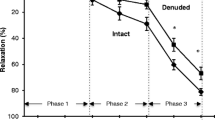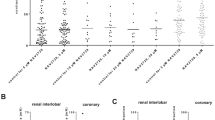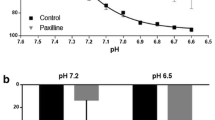Summary
To identify the K+ channels responsible for endothelium-derived hyperpolarizing factor (EDHF)-dependent relaxation, we studied the effects of various K+ channel blockers on acetylcholine-induced relaxation, which persists even in the presence of both an inhibitor of nitric oxide synthase and that of cyclooxygenase, in canine coronary artery rings. A nonselective K+ channel blocker, tetrabutylammonium (TBA), a large and intermediate conductance Ca2+-activated K+ channel blocker, charybdotoxin (CTX), and a voltage-dependent K+ channel blocker, 4-aminopyridine (4-AP), significantly inhibited this residual relaxation. A combined treatment with CTX and 4-AP almost completely blocked the relaxation. Neither a large (iberiotoxin) nor a small (apamin) conductance Ca2+-activated K+ channel blocker blocked the relaxation. We also investigated effects of K+ channel blockers on basal tone to determine whether or not EDHF is involved in regulating basal tone. TBA and CTX substantially raised basal tone to a greater degree in endothelium-intact preparations than in endothelium-denuded preparations. These results indicate that EDHF may exert its relaxing action through intermediate conductance Ca2+-activated and voltage-dependent K+ channels in canine coronary arteries. In addition, EDHF may play a role in maintaining basal vascular tone.
Similar content being viewed by others
References
Chen G, Suzuki H, Weston AH (1988) Acetylcholine releases endothelium-derived hyperpolarizing factor and EDRF from rat blood vessels. Br J Pharmacol 95:1165–1174
Komori K, Lorenz RR, Vanhoutte PM (1988) Nitric oxide, ACh, and electrical and mechanical properties of canine arterial smooth muscle. Am J Physiol 255 (Heart Circ Physiol 24):H207–212
Cohen RA, Vanhoutte PM (1995) Endothelium-dependent hyperpolarization: beyond nitric oxide and cyclic GMP. Circulation 92:3337–3349
Campbell WB, Gebremedhin D, Prattand PF, Harder DR (1996) Identification of epoxyeicosatrienoic acids as endothelium-derived hyperpolarizing factors. Circ Res 78:415–423
Corriu C, Félétou M, Canet E, Vanhoutte PM (1996) Inhibitors of the cytochrome P450-mono-oxygenase and endothelium-dependent hyperpolarizations in the guinea-pig isolated carotid artery. Br J Pharmacol 117:607–610
Kuriyama H, Kitamura K, Nabata H (1995) Pharmacological and physiological significance of ion channels and factors that modulate them in vascular tissues. Pharmacol Rev 47:387–573
Standen NB, Quayle JM, Davies NW, Brayden JE, Huang Y, Nelson MT (1989) Hyperpolarizing vasodilators activate ATP-sensitive K+ channels in arterial smooth muscle. Science 245:177–180
Chen G, Cheung DW (1992) Characterization of acetylcholine-induced membrane hyperpolarization in endothelial cells. Cirs Res 70:257–263
Cowan CL, Palacino JJ, Cohen RA (1993) Potassium channel-mediated relaxation to acetylcholine in rabbit arteries. J Pharmacol Exp Ther 266:1482–1489
Eckman DM, Weinert JS, Buxton ILO, Keef KD (1994) Cyclic GMP-independent relaxation and hyperpolarization with acetylcholine in guinea-pig coronary artery. Br J Pharmacol 111:1053–1060
Chen G, Yamamoto Y, Miwa K, Suzuki H (1991) Hyperpolarization of arterial smooth muscle induced by endothelial humoral substances. Am J Physiol 260 (Heart Circ Physiol 29):H1888–1892
Muramatsu M, Iwama Y, Shimizu K, Asano H, Toki Y, Miyazaki Y, Okumura K, Hashimito H, Ito T (1992) Hypoxia-elicited contraction of aorta and coronary artery via removal of endothelium-derived nitric oxide. Am J Physiol 263 (Heart Circ Physiol 32):H1339–1347
Vane JR (1971) Inhibition of Prostaglandin synthesis as a mechanism of action for aspirin-like drugs. Nature 231:232–235
Nelson MT, Quayle JM (1995) Physiological roles and properties of potassium channels in arterial smooth muscle. Am J Physiol 268 (Cell Physiol 37):C799–822
Parkington HC, Tare M, Tonta MA, Coleman HA (1993) Stretch revealed three components in the hyperpolarization of guinea-pig coronary artery in response to acetylcholine. J Physiol (Lond) 465:459–476
Tare M, Parkington HC, Coleman HA, Neild TO, Dusting GJ (1990) Hyperpolarization and relaxation of arterial smooth muscle caused by nitric oxide derived from the endothelium. Nature 346:69–71
Vanheel B, Van De Voorde J, Leusen I (1994) Contribution of nitric oxide to the endothelium-dependent hyperpolarization in rat aorta. J Physiol (Lond) 475:277–284
Brayden JE, Nelson MT (1992) Regulation of arterial tone by activation of calcium-dependent potassium channels. Science 256:532–535
Leblanc N, Wan X, Leung PM (1994) Physiological role of Ca2+-activated and voltage-dependent K+ currents in rabbit coronary myocytes. Am J Physiol 266 (Cell Physiol 35):C1523–1537
Nagao T, Vanhoutte PM (1992) Hyperpolarization as a mechanism for endothelium-dependent relaxations in the porcine coronary artery. J Physiol (Lond) 445:355–367
Zygmunt PM, Högestätt ED (1996) Role of potassium channels in endothelium-dependent relaxation resistant to nitroarginine in the rat hepatic artery. Br J Pharmacol 117:1600–1606
Rapacon M, Mieyal P, Mcgiff JC, Fulton D, Quilley J (1996) Contribution of calcium-activated potassium channels to the vasodilator effect of bradykinin in the isolated, perfused kidney of the rat. Br J Pharmacol 118:1504–1508
Adegbo ASO, Triggle CR (1993) Varying extracellular [K+]: a functional approach to separating EDHF- and EDNO-related mechanisms in perfused rat mesenteric arterial bed. J Cardiovasc Pharmacol 21:423–429
García Pascual A, Labadía A, Jimenez E, Costa G (1995) Endothelium-dependent relaxation to acetylcholine in bovine oviductal arteries: mediation by nitric oxide and changes in apamin-sensitive K+ conductance. Br J Pharmacol 115:1221–1230
Kitagawa S, Yamaguchi Y, Kunitomo M, Sameshima E, Fujiwara M (1994) NG-nitro-L-arginine-resistant endothelium-dependent relaxation induced by acetylcholine in the rabbit renal artery. Life Sci 55:491–498
Nakashima M, Mombouli JV, Taylor AA, Vanhoutte PM (1993) Endothelium-dependent hyperpolarization caused by bradykinin in human coronary arteries. J Clin Invest 92:2867–2871
O’Rourke ST (1996) Effects of potassium channel blockers on resting tone in isolated coronary arteries. J Cardiovasc Pharmacol 27:636–642
Xu X, Lee KS (1994) Characterization of the ATP-inhibited K+ current in canine coronary smooth muscle cells. Pflügers Arch 427:110–120
Author information
Authors and Affiliations
Additional information
This study was supported in part by a Grant-in-Aid for Scientific Research (B07457167) from the Ministry of Education, Science and Culture of Japan.
Rights and permissions
About this article
Cite this article
Nakashima, Y., Toki, Y., Fukami, Y. et al. Role of K+ channels in EDHF-dependent relaxation induced by acetylcholine in canine coronary artery. Heart Vessels 12, 287–293 (1997). https://doi.org/10.1007/BF02766805
Received:
Revised:
Accepted:
Issue Date:
DOI: https://doi.org/10.1007/BF02766805




